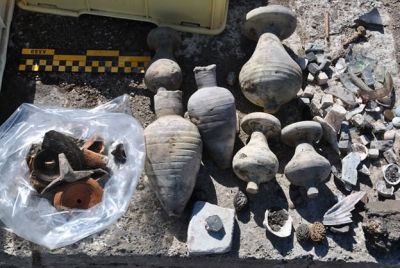A trove of perfectly preserved ceramics, burnt animal bones and a wooden chalice were pulled up from a well in Ostia Antica, shedding new light on religious life at the heart of Ancient Rome. Discarded peach stones, oil lamps and marble fragments dating from the first and second centuries BC were also pulled up from the 3m-deep shaft at Ostia, an ancient port city at the mouth of the Tiber that is now the site of a vast archaeological park. The well is located outside the ruins of the Temple of Hercules in the archaeological site’s so-called sacred area, once home to Ostia’s most important places of worship. Water at the bottom has preserved the artefacts for centuries. Specialists were hoisted inside and they then carefully removed the objects. Recovered pig and cattle bones and ceramics showed burn marks, suggesting the animals had been sacrificed, cooked and eaten during banquets honoring deities. “These finds are a direct testament of the ritual activity that took place at the sanctuary,” Alessandro D’Alessio, director of the Ostia Antica archaeological park, told The Art Newspaper. “We might have imagined this happened but previously we had no evidence.” One of the most spectacular discoveries was a carved wooden chalice or funnel. Archaeologists are still trying to determine its precise function. “Refined objects like this are rare given that wood usually deteriorates,” D’Alessio said. “We believe it may have been used as a musical instrument such as a pipe.” Before Christianity was adopted as the official religion of the Roman empire in 380 AD, Romans typically fulfilled vows to multiple gods, made divine requests and asked for forgiveness by sacrificing animals in designated sacred spaces including altars and temples. Ostia’s sacred area, which was located near a spring along the Via della Foce road that led towards the coast, was discovered in the late 1930s and is currently being restored with a view to opening it to the public.
Un baule che conteneva ceramiche, ossa di animali bruciate e un calice è stato ritrovato in un pozzo di Ostia Antica. Il baule è un'altra testimonianza della vita religiosa degli antichi romani. Nello stesso pozzo si sono trovati anche noccioli di pesca, lucerne e frammenti di marmo. Questi artefatti risalgono al primo e secondo secolo a.C. Ostia Antica è una città alla foce del fiume Tevere che oggi è un parco archeologico. Il pozzo si trova fuori delle rovine del Tempio di Ercole e si trova a più di 3 metri sotto terra. Questa zona è considerata un parco religioso perché era un luogo venerato dagli dei. L'acqua del pozzo ha preservato gli artefatti per secoli. Per recuperare gli oggetti, gli esperti, dovettero salire nel pozzo e raccogliere con cura gli oggetti. Gli esperti hanno trovato ceramica e ossa di maiali e mucche con segni di bruciature che potrebbero significare che furono stati sacrificati, cucinati e mangiati durante un banchetto per onorare gli dei. Alessandro D'Alessio, direttore del parco archeologico di Ostia Antica, ha detto che questi oggetti confermano che fu un rito religioso. Uno degli oggetti più spettacolari è il calice realizzato in legno e all'interno del baule. Il calice ha varie intagli e gli archeologi devono studiarli per capire il significato. Secondo D'Alessio, gli intagli non si sono consumati e questa non è solo una cosa rara ma anche una scoperta incredibile. Prima che il cristianesimo fosse adottato dall'imperatore romano nel 380 a.C., i romani credevano in una varietà di dei. Fu comune per i romani fare sacrifici animali quando pregavano o chiedevano il perdono facendo sacrifici sull'altare o in un tempio. L'area sacra di Ostia si trova lungo la via della Foce che si dirige verso la costa. Fu scoperto nel 1930 e da allora è in fase di restauro. Alcune aree sono aperte al pubblico.



